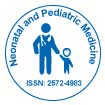Our Group organises 3000+ Global Conferenceseries Events every year across USA, Europe & Asia with support from 1000 more scientific Societies and Publishes 700+ Open Access Journals which contains over 50000 eminent personalities, reputed scientists as editorial board members.
Open Access Journals gaining more Readers and Citations
700 Journals and 15,000,000 Readers Each Journal is getting 25,000+ Readers
Recommended Conferences
42nd Global Conference on Nursing Care & Patient Safety
Toronto, CanadaGoogle Scholar citation report
Citations : 303
Neonatal and Pediatric Medicine received 303 citations as per Google Scholar report
Indexed In
- Google Scholar
- RefSeek
- Hamdard University
- EBSCO A-Z
- ICMJE
Useful Links
Recommended Journals
Related Subjects
Share This Page
Implementation of a new protocol for Patent Ductus Arteriosus medical closure in premature infants less than 28 weeks and 1000 grams: practice in a French level-III hospital
World Neonatology and Child Care Meeting
Elie Ghoussoub
Paris-Decartes University, France
Posters & Accepted Abstracts: Neonat Pediatr Med
Abstract
Pulmonary hemorrhage is frequently associated with hemodynamically-significant Patent Ductus Arteriosus (hsPDA) especially in premature infants, and considered a major risk for mortality and morbidities in this population. We have studied pulmonary hemorrhage incidence in extreme premature infants after the implementation of a new protocol of early ultrasonographic diagnosis followed by ibuprofen-based treatment. In 2016, a new protocol was introduced for early diagnosis and treatment within the first 24 hours of life of premature infants born less than 26 weeks of gestation and/or less than 1000 grams. Three of the 4 criteria present on cardiac ultrasound (12 to 24 hours of life) were needed to confirm hsPDA: Left atrium/Aorta ratio > 1.5 mm, Ductus arteriosus diameter > 1.5 mm, Transductal flow velocity < 2 m/sec and mean left pulmonary artery velocity > 0.2 m/sec. We realized a study divided into 2 parts. The first one was retrospective of children born from September 2015 to August 2016 (PDA-1) and the second prospective of children born from September 2016 to May 2017 (PDA-2). 55 premature infants were illegible for the study: 31 in PDA-1 cohort and 24 in PDA-2 group. We noticed a tendency to a reduction in the incidence of pulmonary hemorrhage in PDA-2 compared to PDA-1 cohort (4.3% vs. 29.1% respectively; p = .055) but not statistically significant. The survival rate was increased by third in PDA-2 group (91.5% vs. 67.7%; p=.033). Screening and early-treatment of a hsPDA did not show a significant reduction of pulmonary hemorrhage incidence, but increased the survival rate of infants born less than 26 weeks of gestation and/or less than 1000 grams by third.Biography

 Spanish
Spanish  Chinese
Chinese  Russian
Russian  German
German  French
French  Japanese
Japanese  Portuguese
Portuguese  Hindi
Hindi 